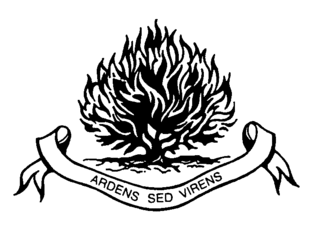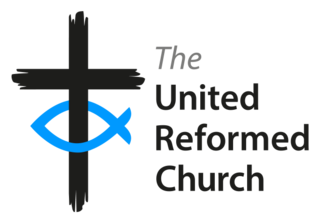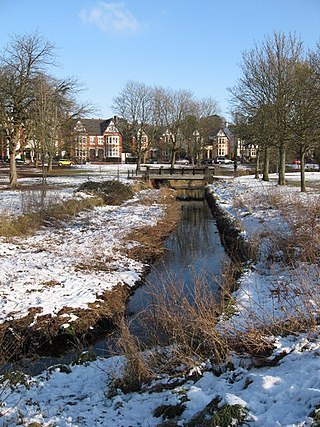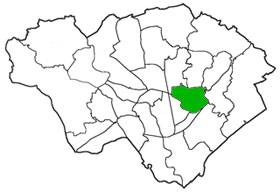
Presbyterianism is a part of the Reformed tradition within Protestantism that broke from the Roman Catholic Church. Presbyterian churches derive their name from the presbyterian form of church government by representative assemblies of elders. Many Reformed churches are organised this way, but the word Presbyterian, when capitalized, is often applied to churches that trace their roots to the Church of Scotland or to English Dissenter groups that formed during the English Civil War.

The United Reformed Church (URC) is a Protestant Christian church in the United Kingdom. As of 2022 it has approximately 40,000 members in 1,284 congregations with 334 stipendiary ministers.

Roath is a district and community to the north-east of the city centre of Cardiff, capital of Wales. The area is mostly covered by the Plasnewydd electoral ward, and stretches from Adamsdown in the south to Roath Park in the north.

The Free Church of Scotland is an evangelical, Calvinist denomination in Scotland. It was historically part of the original Free Church of Scotland that remained outside the union with the United Presbyterian Church of Scotland in 1900. Now, it remains a distinct Presbyterian denomination in Scotland.

Penylan is a district and community in the east of Cardiff, the capital city of Wales, known for its Edwardian era period houses and spacious tree lined roads and avenues.

Cwmbach is a village and community near Aberdare, in the county borough of Rhondda Cynon Taf, Wales. Cwmbach means 'Little Valley' in Welsh. Cwmbach has a population of 5,117.

Downing Place United Reformed Church, Cambridge is a church in Cambridge, United Kingdom, that is part of the United Reformed Church. It was formed in 2018 in a merger between St Columba's Church, Cambridge, and Emmanuel Church, Cambridge. The church occupies the former St Columba's building in Downing Place, which is close to a site occupied by Emmanuel's congregation before 1874.

Avenue St. Andrew's is a United Reformed Church in Southampton, England. Part of the church building is Grade II listed.

The National Presbyterian Church is a Christian congregation of approximately 1,500 members of all ages from the greater metropolitan Washington, D.C., area. The mission statement of the church is "Leading People to Become Faithful Followers of Jesus Christ Together in God’s World"

First Presbyterian Church is located in central Davenport, Iowa, United States. It was listed on the National Register of Historic Places in 1983. The congregation is associated with the Presbyterian Church (USA).

St Luke's Church is a United Reformed church in the Silverhill suburb of Hastings, a town and borough in East Sussex, England. The congregation was originally independent before taking up Presbyterianism, and worshipped in a private house from its founding in 1853 until a permanent church was provided in 1857; this was one of the oldest Presbyterian places of worship in southeast England. The growth of the community has resulted in several extensions since then, and severe damage caused by the Great Storm of 1987 was quickly repaired—except for the loss of the building's distinctive spire. The church, along with most other Presbyterian congregations, joined the United Reformed Church when that denomination was formed in 1972. It is one of four United Reformed Churches in the borough of Hastings.

The United Reformed Church is a congregation in Stamford, Lincolnshire, based in a late-Georgian building situated on Star Lane.

The Brick Presbyterian Church is a large congregation at Park Avenue and 91st Street on the Upper East Side of Manhattan in New York City. A member of the Presbyterian Church, it is known for its Day School and music programs. It was founded as an offshoot of First Presbyterian Church. Its first building, in Lower Manhattan, opened in 1768. The Park Avenue location opened April 14, 1940.

Habershon & Fawckner or Habershon, Pite & Fawckner was a British architectural practice active in England and Wales from the 1860s, particularly in Cardiff and the South Wales area. They had had offices in London, Cardiff and Newport, designing a large number of houses, villas and non-conformist chapels.

St Columba's United Reformed Church is a congregation of the United Reformed Church (URC) in the centre of the city of Oxford. It is located on Alfred Street, off the High Street.

Parkminster United Reformed Church is located in Roath, Cardiff.

Tabernacle is a listed place of worship in the suburb of Roath, Cardiff, Wales.

Robertson Street Congregational Church is a former United Reformed church in the centre of Hastings, a seaside town and borough in East Sussex, England. Built in 1885 on the site of an earlier church which had been constructed in 1857, it was designed by Henry Ward (1854–1927), who was responsible for many of the key buildings in the town of Hastings, not least the Town Hall. The building, a "large urban ... church with richly detailed exteriors and interiors", is situated between Robertson Street and Cambridge Road and has a split-level arrangement with part of the gallery occupying a flying freehold over the alleyway adjacent to the entrance on Robertson Street. The church is listed at Grade II for its architectural and historical importance.

The Weybridge United Reformed Church situate at Queen's Road, Weybridge, near to its junction with York Road, is a Victorian Grade II Listed church building that is now no longer used as a place of worship.





















